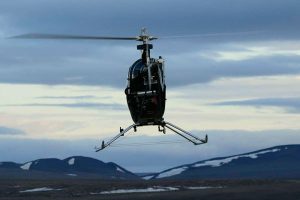Researchers test drones up north
By Lookout on Sep 29, 2014 with Comments 0

Janice Lang, DRDC photographer
Left: The Aphid Unmanned Aerial Vehicle (UAV) soars above the testing ground at Canadian Forces Station Alert. Used for scouting and surveillance, this small, remotely controlled helicopter is capable of flying 100km/h.
DND is currently using test drones and looking into the viability of using unmanned systems in the North.
In August, 14 scientific and military personnel travelled to Canadian Forces Station (CFS) Alert, Nunavut, to test the viability of both ground and aerial unmanned vehicles—also called drones—in arctic environments.
Conducting eight experiments over a 12 day period, the viability of these vehicles was tested in search and rescue, hazard mitigation, and communications simulations.
“We were interested in the deployment of unmanned vehicles in terms of supporting DND operations,” says Dr. Simon Monckton, a scientist with Defence Research and Development Canada (DRDC), and the lead Unmanned Aerial Vehicle (UAV) scientist on the Joint Arctic Experiment. “Unmanned vehicles have never been piloted this far north before, so we were unsure how they would operate in such an extreme environment. It was our biggest question setting out.”
During the exercise, two types of unmanned vehicles were implemented. The first, the Unmanned Ground Vehicles (UGV), were used for up-close investigation. About the size of a two-person All-Terrain-Vehicle, they were outfitted with tracks instead of tires to navigate the rugged Arctic environment. One of the two UGVs also featured a large manipulator arm on the front bumper, which is capable of lifting 200lbs at full extension. Teams in a large tracked vehicle following the UGVs piloted them remotely.
The UAVs were utilized for surveillance, mapping, and reconnaissance. Converted from commercially available helicopters, they are about six-metres long, and feature a variety of still and video equipment. They can fly 100km/h for an hour and half before refuelling. Teams situated in a fixed location such as CFS Alert piloted the UAVs remotely.
The exercises worked off a fictional scenario involving a downed satellite, and pertained to the detection, mapping, and investigation of the satellite; the detection, mapping, and cleanup of a potential radiological hazard; the searching for safe routes of personnel; and the search and recovery of possible causalities.
“We expected lots of high winds and rain in the environment, but when we arrived we discovered the weather alternated between calm and foggy, and high winds with clear skies,” says Dr. Monckton. “Since the UAVs could only operate with calm skies we had to rush to catch windows. Fortunately we had a number of those windows.”
He says they had to wait for clear weather before using the relatively fragile UAVs, but the UGV teams had the opposite experience.
“They were immune to the weather, so they could operate in any condition. Though they weren’t fast, and would take a beating whenever they went out, they operated 80 hours before they had mechanical problems. During one exercise they drove eight kilometres unmanned, which is a record for them.”
Dr. Monckton says he and the team were, overall, very happy with how the vehicles performed. From their delivery to CFS Alert, to their operation in the rugged and extreme conditions, they performed well. However, before a conclusive answer can be given to the question of unmanned vehicles in the Arctic, there are many more questions to be asked.
“This may just be the scientist speaking, but there are more tests needed,” he says. “The purpose of this exercise was to determine what else needs to be done. In terms of deciding where the deficits are, and how to rectify them, this exercise served its purpose. It’s just a matter of deciding where we go next.”
Shawn O’Hara, Staff Writer
Filed Under: Top Stories
About the Author:





